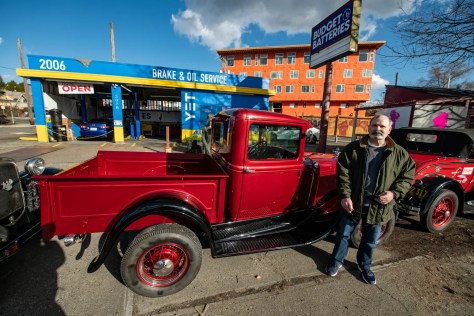NOTE: To see a July 28, 2021, story in the Mukilteo Beacon updating the saga of the missing plaque, click here.
= = = = =
(Click and click again to enlarge photos)




(Published in the Seattle Times online on April 1, 2021
and in PacificNW Magazine of the print Times on April 4, 2021)
Treaty monument in Mukilteo is plaqueless — perhaps forever?
By Clay Eals
Sometimes history isn’t where you think you’ll find it.
Case in point: the Jan. 22, 1855, accord known as the Point Elliott Treaty, signed with an “X” by Chief Seattle and 81 other Puget Sound tribal leaders.
While it conferred tribal sovereignty and later was judicially interpreted to protect tribal fishing rights, it also ceded countless acres of land to European newcomers and has long been considered a lordly license for settler supremacy.
Nearly 90 years ago, a ceremony commemorated the treaty with a granite monument. The marker was installed at Third and Lincoln in downtown Mukilteo, a site thought to be near the place the treaty was signed. A Daughters of the American Revolution event on May 2, 1931, drew more than 3,000 people, including 300 Native Americans, some who were descendants of the treaty signers.

To absorb the dedication’s hillside milieu, I recently drove north to see the marker at its Mukilteo city block. Imagine my surprise when I reached the stone and found its plaque missing. All that remained in its rectangular frame were three screw holes and a washered pin.
The plaque has been gone since October, when the city discovered its absence, along with graffiti that covered the monument. The scrawls included an anarchist symbol, an expletive and the phrase “BROKEN TREATIES.” Staff scrubbed off the defacement but have puzzled over the plaque’s whereabouts.
Jennifer Gregerson, two-term mayor of Mukilteo, issued a statement hinting that the plaque would not be replaced: “The signing location itself has an important significance in our shared history with the Northwest tribes. I believe this act of vandalism can provide an opportunity to spur our community forward into a new conversation. I hope that we can find a different way to explain and acknowledge that history at this site in Mukilteo.”
The Mukilteo Historical Society doesn’t plan to weigh in on the monument’s future, but Joanne Mulloy, president, is curious about what, if anything, the city will do.
Leaving the marker plaqueless appeals to Ken Workman, fourth-generation great grandson of Chief Seattle, whose Duwamish Tribe still lacks federal recognition. Lyrically, Workman notes that granite and computer memory chips both contain silicon.
“Granite holds the memories of people,” he says. “It’s a symbolic link to the genetic pain of 170 years.”
WEB EXTRAS
To see Jean Sherrard‘s 360-degree video of the “Now” prospect and compare it with the “Then” photo, and to hear this column read aloud by Clay Eals, check out our Seattle Now & Then 360 version of the column!
Below are a photo, brochure, a HistoryLink backgrounder, a map, a DAR timeline and, in chronological order, four historical clippings from The Seattle Times and Seattle Post-Intelligencer online archives (available via Seattle Public Library) and other online newspaper sources that were helpful in the preparation of this column.
Special thanks to local historian Phil Hoffman and his Alki History Project for the initial idea for this installment and for invaluable assistance. He reminds us that the formal name of the Point Elliott Treaty is “Treaty between the United States and the Duwamish, Suquamish, and other allied and subordinate tribes of Indians in Washington Territory.” Hoffman adds, “I am operating on the premise that what we call things reveals what we really think and our biases.”
Joanne Mulloy, president of the Mukilteo Historical Society, offers this additional information and insight: “John Collier, our past president, wrote a quote that I quite like: ‘The Point Elliott Treaty remains a significant historical event for both the Tulalip people and the City of Mukilteo. As such, it should be remembered and, more important, continue to be studied as a means of strengthening cooperation and progress today.’ There are several plaques down at Lighthouse Park still. One was leftover from a bench that was on the beach in the 1950s, but the bench washed out in the Sound.”




































































































































































































